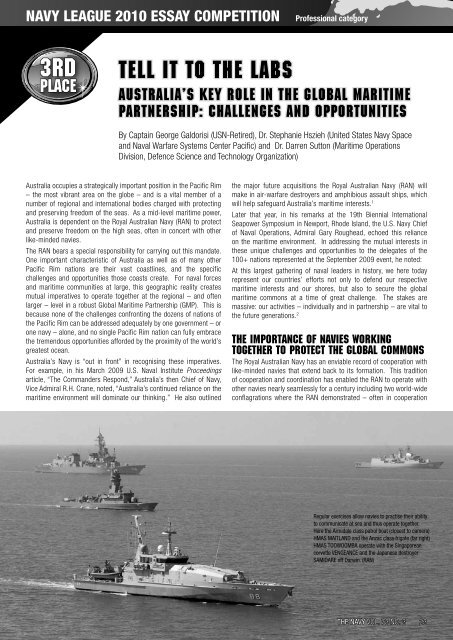The Navy Vol_73_No_3 Jul 2011 - Navy League of Australia
The Navy Vol_73_No_3 Jul 2011 - Navy League of Australia
The Navy Vol_73_No_3 Jul 2011 - Navy League of Australia
You also want an ePaper? Increase the reach of your titles
YUMPU automatically turns print PDFs into web optimized ePapers that Google loves.
NAVY LEAGUE 2010 ESSAY COMPETITION<br />
Pr<strong>of</strong>essional category<br />
3RD<br />
PLACE<br />
Tell it to the Labs<br />
<strong>Australia</strong>’s Key Role in the Global Maritime<br />
Partnership: Challenges and Opportunities<br />
By Captain George Galdorisi (USN-Retired), Dr. Stephanie Hszieh (United States <strong>Navy</strong> Space<br />
and Naval Warfare Systems Center Pacific) and Dr. Darren Sutton (Maritime Operations<br />
Division, Defence Science and Technology Organization)<br />
<strong>Australia</strong> occupies a strategically important position in the Pacific Rim<br />
– the most vibrant area on the globe – and is a vital member <strong>of</strong> a<br />
number <strong>of</strong> regional and international bodies charged with protecting<br />
and preserving freedom <strong>of</strong> the seas. As a mid-level maritime power,<br />
<strong>Australia</strong> is dependent on the Royal <strong>Australia</strong>n <strong>Navy</strong> (RAN) to protect<br />
and preserve freedom on the high seas, <strong>of</strong>ten in concert with other<br />
like-minded navies.<br />
<strong>The</strong> RAN bears a special responsibility for carrying out this mandate.<br />
One important characteristic <strong>of</strong> <strong>Australia</strong> as well as <strong>of</strong> many other<br />
Pacific Rim nations are their vast coastlines, and the specific<br />
challenges and opportunities those coasts create. For naval forces<br />
and maritime communities at large, this geographic reality creates<br />
mutual imperatives to operate together at the regional – and <strong>of</strong>ten<br />
larger – level in a robust Global Maritime Partnership (GMP). This is<br />
because none <strong>of</strong> the challenges confronting the dozens <strong>of</strong> nations <strong>of</strong><br />
the Pacific Rim can be addressed adequately by one government – or<br />
one navy – alone, and no single Pacific Rim nation can fully embrace<br />
the tremendous opportunities afforded by the proximity <strong>of</strong> the world’s<br />
greatest ocean.<br />
<strong>Australia</strong>’s <strong>Navy</strong> is “out in front” in recognising these imperatives.<br />
For example, in his March 2009 U.S. Naval Institute Proceedings<br />
article, “<strong>The</strong> Commanders Respond,” <strong>Australia</strong>’s then Chief <strong>of</strong> <strong>Navy</strong>,<br />
Vice Admiral R.H. Crane, noted, “<strong>Australia</strong>’s continued reliance on the<br />
maritime environment will dominate our thinking.” He also outlined<br />
the major future acquisitions the Royal <strong>Australia</strong>n <strong>Navy</strong> (RAN) will<br />
make in air-warfare destroyers and amphibious assault ships, which<br />
will help safeguard <strong>Australia</strong>’s maritime interests. 1<br />
Later that year, in his remarks at the 19th Biennial International<br />
Seapower Symposium in Newport, Rhode Island, the U.S. <strong>Navy</strong> Chief<br />
<strong>of</strong> Naval Operations, Admiral Gary Roughead, echoed this reliance<br />
on the maritime environment. In addressing the mutual interests in<br />
these unique challenges and opportunities to the delegates <strong>of</strong> the<br />
100+ nations represented at the September 2009 event, he noted:<br />
At this largest gathering <strong>of</strong> naval leaders in history, we here today<br />
represent our countries’ efforts not only to defend our respective<br />
maritime interests and our shores, but also to secure the global<br />
maritime commons at a time <strong>of</strong> great challenge. <strong>The</strong> stakes are<br />
massive: our activities – individually and in partnership – are vital to<br />
the future generations. 2<br />
THE IMPORTANCE OF NAVIES WORKING<br />
TOGETHER TO PROTECT THE GLOBAL COMMONS<br />
<strong>The</strong> Royal <strong>Australia</strong>n <strong>Navy</strong> has an enviable record <strong>of</strong> cooperation with<br />
like-minded navies that extend back to its formation. This tradition<br />
<strong>of</strong> cooperation and coordination has enabled the RAN to operate with<br />
other navies nearly seamlessly for a century including two world-wide<br />
conflagrations where the RAN demonstrated – <strong>of</strong>ten in cooperation<br />
Regular exercises allow navies to practise their ability<br />
to communicate at sea and thus operate together.<br />
Here the Armidale class patrol boat (closest to camera)<br />
HMAS MAITLAND and the Anzac class frigate (far right)<br />
HMAS TOOWOOMBA operate with the Singaporean<br />
corvette VENGEANCE and the Japanese destroyer<br />
SAMIDARE <strong>of</strong>f Darwin. (RAN)<br />
THE NAVY VOL. <strong>73</strong> NO. 3 23

















